Swiss brush company Ebnat-Kappel uses non contact transfer technology from Bosch Rexroth to automate a problematic section of its packaging production process.
Have you ever tried to pick up one single plastic bag from a pile, only to find that the bags “stick” to each other and instead of taking just one, you lift up one or two others as well? At Ebnat-Kappel AG, a Swiss manufacturer of high-quality brushes, the ability to efficiently separate, lift and open plastic bags is a crucial step in the production process of the Interdental Flosser packaging machine. However, automating this step of the packaging process proved extremely difficult. The plastic bags could not be individually lifted and opened by applying conventional vacuum technology.
Despite the difficulties, the Ebnat-Kappel AG brush factory, known by their brand name “Ebnat Switzerland”, still wanted to automate this complicated section of the packaging process and fill their Interdental Flossers into bags. “In such a situation, it’s hard to know what to do,” remembers Gottfried Kaufmann, Purchasing Team Manager at the brush specialists. “Packaging Interdental Flossers into plastic bags was just impossible with standard vacuum lifters and this is why we tested handling with the Non Contact Transfer (NCT) unit from Bosch Rexroth.”
Lifting Force Generated by a Vacuum
The NCT allows non-contact material handling. It lifts objects without any surface contact at all. What looks like magic, is, in fact, based on a physical law: the Bernoulli principle (see sidebar for more information). The air flow under the NCT generates a vacuum and creates a lifting force between the NCT and the object with a minimum air pocket between them. The transport unit operates at pressures from 1 to 7 bar (15 to 102 psi), and is ideal for applications where handling of porous or permeable workpieces, objects with rough or dusty surfaces, or soft materials such as the plastic bags from the Ebnat-Kappel brush factory is required.
“We need two NCTs each with a 60-millimeter diameter for our application,” explains Gottfried Kaufmann. Each of the NCT60s delivers 6.0 Newton lifting force at 5 bar (73 psi). A longitudinal conveyor and filling funnel are used to prepare the Interdental Flossers for packaging. A pile of empty plastic bags is located at the bottom of the machine. The first NCT moves in from the right-hand side and lifts a bag from the top of the pile. The NCT is then rotated by 90 degrees into a vertical position with a swivel arm.
The air flow on the second NCT on the left is then generated to open the bag so that it can be filled from above with brush parts. The NCT on the left then drops the bag by deactivating the air flow that generates the vacuum and returns to its starting position. Finally, the NCT attached to the swivel arm releases the filled bag onto a conveyor belt and also returns to its original position.
Successful Tests
The entire process appears quite simple, however it poses hidden difficulties. “We tested other technical solutions for this handling job. However, we discovered that these plastic bags are just not compatible with other technologies, particularly vacuum lifters,” emphasizes Kaufmann. “When applying the vacuum technology, we found that it was sucking in dirt and causing the plastic bags to crease. Both of these disruptive factors have to be excluded when packaging the Interdental Flossers. The NCT was the only solution we could use – without it, we could never have automated this step of our production process.”
This traditional brush specialist with modern production facilities for approximately 1000 different products was already familiar with the NCT through a presentation. “We first tested the NCT with 0.3 to 0.5 millimeter-thick cardboard boxes for blister packaging with perforations as well as with beakers for travel toothbrush sets. Lifting proved no problem at all which was confirmed in another test with floor mops which we conducted with three NCT40s,” confirms Kaufmann and adds: “We observed outstanding results with tests on the plastic beakers. While standard vacuum lifters left slight marks on the smooth surface, the NCT left none at all during handling.”
Fast Packaging on Order
The NCT appealed to decision-makers at the Ebnat-Kappel brush factory, who were open to this new solution, particularly as the two non-contact transport units achieve cycle times of five to ten seconds to fill the plastic bags. Gottfried Kaufmann emphasizes that, besides solving the handling task, speed was also a vital factor: “We only supply these Interdental Flossers on order, which means that they have to be packaged as fast as possible. The trouble-free separation and opening of the plastic bags plays an important role here.”
Carried by Air – the Bernoulli Principle
Daniel Bernoulli (1700-1782), a Dutch-born Swiss scientist, discovered the principles of hydrodynamics and studied fluid flow. From these studies, he deducted the physical law known today as the “Bernoulli principle” which states that as the speed of a moving fluid (gas or liquid) increases, the pressure within the fluid decreases. In accordance with the Bernoulli principle, the entire energy within a stationary flow is constant throughout the entire flow path. As a result, the increase in the flow speed is always accompanied by a decrease in pressure.
The principle also describes the flow along surfaces. An airplane wing is designed so that the air moves faster over the upper wing surface than along the lower surface. This effect generates a lower pressure on the upper surface than on the lower surface. The differential pressure causes the airplane to stay in the air. Water propellers also have a similar structure to a wing. As a propeller rotates, it generates a differential pressure between the front and back of the blade which propels the ship or airplane. You can test the principle yourself in a simple experiment by holding one sheet of paper over another and blowing air between them.
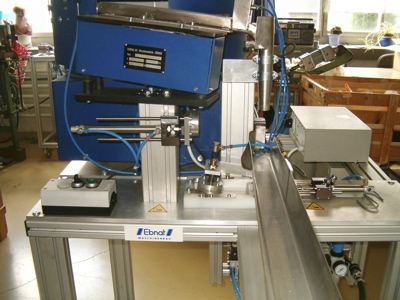
To fill the plastic bags with Interdental Flossers, the dental hygiene products are transported along a longitudinal conveyor and filled into the bag through a funnel. The individual bags first have to be lifted and opened cleanly without creasing.
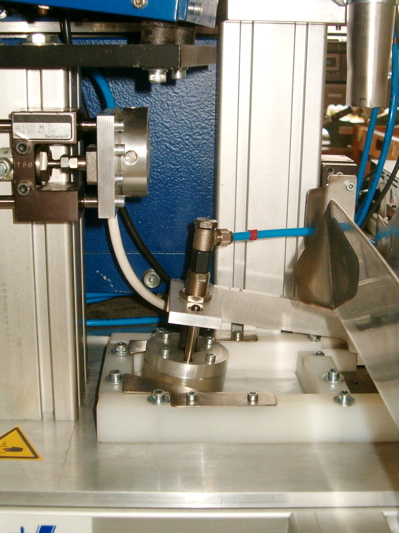
The first NCT60 positions itself above the pile of plastic bags. By generating a vacuum with the air flow, it lifts the bag on top of the pile without any contact and rotates it by 90 degrees into a vertical position.
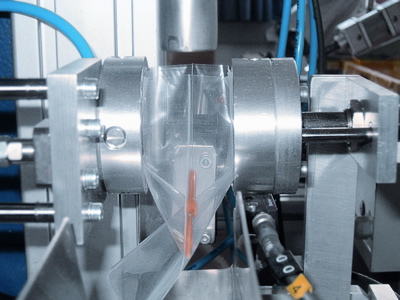
Once the first NCT is holding the bag vertically, the second NCT moves in to open the plastic bag. An air pocket between the NCT and object lifts and opens the bag without any surface contact at all.
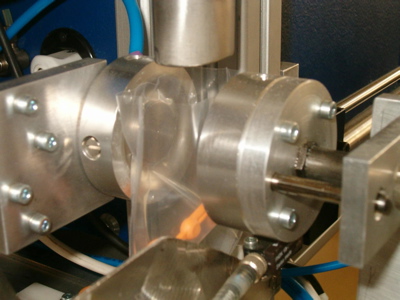
In contrast to vacuum lifters, the NCT technology does not suck in any dirt or crease the plastic bag and ensures smooth handling of the packaging bags.
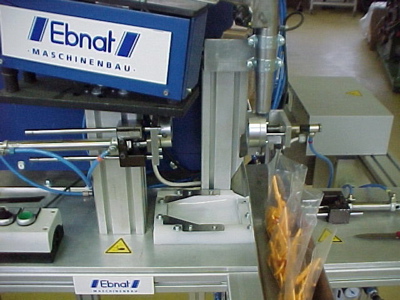
Lifting, opening and filling one plastic bag with Interdental Flossers takes just five to ten seconds. By employing two NCT60s, this process at the Ebnat-Kappel AG brush factory could be automated and is now fast and efficient.
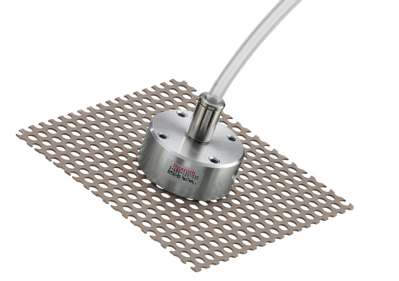
The NCT is suitable for even the most difficult handling tasks, capable of lifting porous, permeable or soft workpieces, and objects with rough or dusty surfaces.
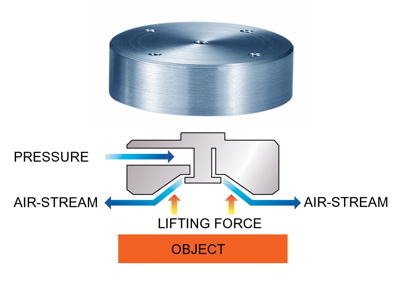
The air flow under the NCT generates a vacuum which serves as a lifting force to “hold” objects without touching them. The transport unit is ideal for tasks where direct contact with the object's surface is just not possible.
For more information contact Phil O’Neil, Bosch Rexroth Pneumatics.



